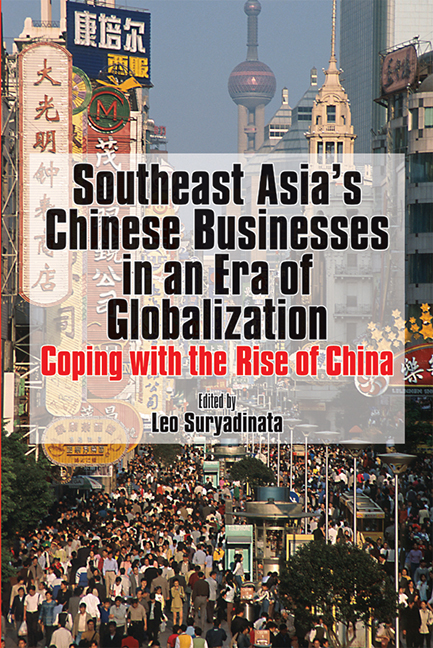Book contents
- Frontmatter
- Contents
- The Contributors
- Introduction
- China and Southeast Asia
- Indonesia
- Malaysia
- 6 China's Economic Rise and Its Impact on Malaysian Chinese Business
- 7 Competition, (Ir)relevance and Market Determinations: Government Economic Policies and Ethnic Chinese Responses in West Malaysia
- 8 Malaysian Chinese Businesses in an Era of Globalization
- The Philippines
- Singapore and Thailand
- Index
8 - Malaysian Chinese Businesses in an Era of Globalization
from Malaysia
Published online by Cambridge University Press: 21 October 2015
- Frontmatter
- Contents
- The Contributors
- Introduction
- China and Southeast Asia
- Indonesia
- Malaysia
- 6 China's Economic Rise and Its Impact on Malaysian Chinese Business
- 7 Competition, (Ir)relevance and Market Determinations: Government Economic Policies and Ethnic Chinese Responses in West Malaysia
- 8 Malaysian Chinese Businesses in an Era of Globalization
- The Philippines
- Singapore and Thailand
- Index
Summary
INTRODUCTION
People often see globalization as the formation of a global village. The advent of information and communication technology (ICT) has shortened the distance between different parts of the world. We have closer contact and speedier flows of information, enabling the creation of a global civilization, with freer trade, freer flows of people, of capital and of technology. IMF defines globalization as “the growing economic interdependence of countries worldwide through increasing volume and variety of cross-border transactions in goods and services, freer international capital flows, and more rapid and widespread diffusion of technology”.
The recognition of comparative advantages conferred to each country leads to increasing specialization of nations in exports, and pressure to trade liberalization, such as ending protective tariff and other barriers to trade.
In the nineteenth century, trade liberalization was facilitated by adoption of the gold standard along with the growth of industrialization. Globalization has been disrupted since World War I. In the era since World War II, globalization has been driven by trade negotiation rounds, which led to a series of agreements to liberalize trade. The Uruguay Round led to a treaty to create the World Trade Organization (WTO) to mediate trade disputes. Other bilateral trade agreements and regional trade treaty such as the ASEAN Free Trade Area has also been signed in pursuit of the goal of reducing tariffs and barriers in trade.
Since World War II, globalization has manifested itself through the reduction of trade barriers, increase in international trade and foreign direct investments besides increase in international cultural exchanges, international travel and tourism and immigration.
In this era of information and communication technology, globalization is here to stay. The advent of information and communication technology such as Internet enables vast amount of information to be processed and transmitted speedily through an e-commerce portal. Producers can access to global sources of inputs and screen for the most cost-effective producers of such inputs.
- Type
- Chapter
- Information
- Southeast Asia's Chinese Businesses in an Era of GlobalizationCoping with the Rise of China, pp. 205 - 220Publisher: ISEAS–Yusof Ishak InstitutePrint publication year: 2006



